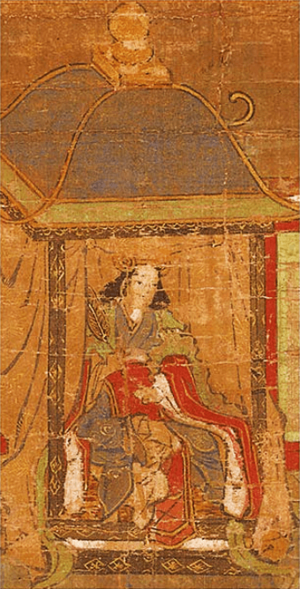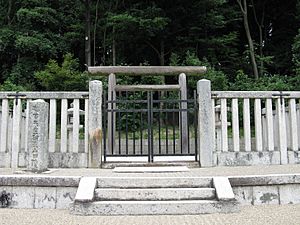Empress Suiko facts for kids
Quick facts for kids Empress Suiko推古天皇 |
|||||
|---|---|---|---|---|---|

Painting of Suiko by Tosa Mitsuyoshi, 1726
|
|||||
| Empress regnant of Japan | |||||
| Reign | 15 January 593 – 15 April 628 (Gregorian calendar) or 8 December 592 – 7 March 628 (Lunar calendar) |
||||
| Predecessor | Sushun | ||||
| Successor | Jomei | ||||
| Regent | Prince Shōtoku (593–621) Soga no Umako Soga no Emishi |
||||
| Empress consort of Japan | |||||
| Tenure | 576 – 585 | ||||
| Born | Nukatabe (額田部) 3 January 554 |
||||
| Died | 15 April 628 (aged 74) | ||||
| Burial | Shinaga no Yamada no misasagi (磯長山田陵) | ||||
| Spouse | Emperor Bidatsu | ||||
| Issue |
|
||||
|
|||||
| House | Yamato | ||||
| Father | Emperor Kinmei | ||||
| Mother | Soga no Kitashihime | ||||
Empress Suiko (推古天皇, Suiko-tennō) (born in 554, died April 15, 628) was a very important leader in ancient Japan. She was the 33rd monarch of Japan, following the traditional list of rulers.
Empress Suiko ruled from 593 until her death in 628. She was the first of eight women to become an empress regnant (a female ruler) in Japan's long history. Other empresses who ruled after her included Kōgyoku, Jitō, Genmei, Genshō, Kōken, Meishō, and Go-Sakuramachi.
Contents
Empress Suiko's Early Life
Before she became empress, her personal name was Princess Nukatabe. She was a daughter of Emperor Kinmei. Her mother was Soga no Kitashihime. Suiko was also the younger sister of Emperor Yōmei.
Becoming Empress

Princess Nukatabe married her half-brother, Emperor Bidatsu. After his first wife passed away, she became his official wife, known as Ōkisaki. They had eight children together.
After Emperor Bidatsu died, Suiko's brother, Emperor Yōmei, became emperor for about two years. When he died, there was a big power struggle. Two powerful families, the Soga clan and the Mononobe clan, fought over who would be the next emperor. The Soga clan won, and Emperor Sushun became the new ruler in 587.
However, Emperor Sushun started to dislike how much power Soga no Umako, the head of the Soga clan, had. Fearing for his own safety, Soga no Umako had Emperor Sushun killed in 592. To prevent another fight for power, Empress Suiko was chosen to become the next ruler. This was a unique event in Japanese history at the time.
- 593: Empress Suiko officially became the empress. This was a way to bring peace and stability back to the country.
At that time, the title "tennō" (emperor) was not yet commonly used. Instead, she might have been called Sumeramikoto or Amenoshita Shiroshimesu Ōkimi. Both titles mean "the great Queen who rules all under heaven."
Key Events During Her Reign
Prince Shōtoku was appointed as a regent (someone who rules for a monarch who is too young or unable to rule) the year after Suiko became empress. Many historians believe that Prince Shōtoku and Soga no Umako held much of the political power. However, Empress Suiko was still a strong leader. The fact that she ruled for so long shows she had great political skills.
Important Changes and Achievements
Empress Suiko's reign saw many important changes in Japan:
- In 594, she officially recognized Buddhism. This was a major step in making Buddhism a widespread religion in Japan. Empress Suiko herself had become a Buddhist nun before she became empress.
- In 600, Japan started having official relations with the Sui dynasty in China. This helped Japan learn new ideas and technologies from China.
- In 603, the Twelve Level Cap and Rank System was adopted. This was a new way to rank government officials based on their skills, not just their family name.
- In 604, the Seventeen-article constitution was adopted. This was a set of moral rules for government officials and the people, focusing on harmony and respect.
- Also in 604, the Sexagenary cycle calendar was adopted in Japan. This was a new way to keep track of years and dates.
In 599, a large earthquake hit the Yamato Province, which is now Nara Prefecture. It caused a lot of damage to buildings.
Empress Suiko showed her independence in 624. Soga no Umako asked her to give him a special imperial territory called Kazuraki no Agata. Empress Suiko refused his request. This showed that she was not just a puppet ruler and could make her own decisions.
Succession and Legacy
Empress Suiko ruled for 35 years. When she was dying, she did not clearly name her successor. She gave vague hints about two possible candidates. One was Prince Tamura, a grandson of Emperor Bidatsu. He was supported by the main Soga family. The other was Prince Yamashiro, a son of Prince Shōtoku. He had support from some other Soga family members.
After a short struggle within the Soga clan, Prince Tamura was chosen. He became Emperor Jomei in 629.
Even though there were other empresses who ruled after Suiko, their successors were usually male. This is why some scholars argue that female reigns were only temporary. However, Empress Genmei was followed by her daughter, Empress Genshō, which is a unique case.
Empress Suiko's Burial Place
The exact location of Empress Suiko's grave is known. She is honored at a special memorial Shinto shrine called a misasagi in Osaka. The Imperial Household Agency officially calls this location Shinaga no Yamada no misasagi.
Empress Suiko's Family
Empress Suiko, born as Princess Nukatabe, was the daughter of Emperor Kinmei and his wife, Soga no Kitashihime. She had five full sisters and seven full brothers. Her eldest brother became Emperor Yōmei.
She married her eldest half-brother, Emperor Bidatsu. They had eight children, but none of them became emperor or empress.
- Husband: Prince Nunakakura no Futo Tamashiki no Sumeramikoto, who later became Emperor Bidatsu.
- Children:
- Princess Uji no Shitsukahi (born 570), who married Prince Shōtoku.
- Prince Takeda
- Princess Woharida (born 572), who married Prince Oshisako-no-Hikohito-no-Oe.
- Princess Umori
- Prince Wohari
- Prince Owari, who was the father of Tachibana-no-Oiratsume (one of Prince Shōtoku's wives).
- Princess Tame, who married Emperor Jomei.
- Princess Sakurawi no Yumihari, who married Prince Oshisako-no-Hikohito-no-Oe, and later Prince Kume (son of Emperor Yōmei).
- Children:
See also
 In Spanish: Suiko Tennō para niños
In Spanish: Suiko Tennō para niños
- Empress Jingū, a semi-legendary empress who ruled before Empress Suiko.
- Empress of Japan
- Emperor of Japan
- List of Emperors of Japan
- Imperial cult
- Suiko period


